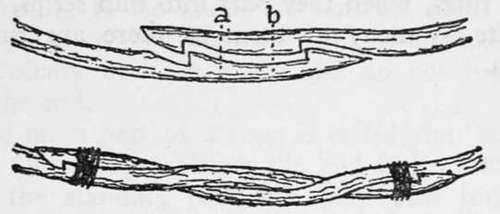Hoops And Splits
Description
This section is from the book "Camping And Woodcraft", by Horace Kephart. Also available from Amazon: Camping and Woodcraft.
Hoops And Splits
The best hoops are made from hickory, white or black ash, birch, alder, arbor-vitae or other cedar, dogwood, and various oaks. Take sprouts or seedlings and split down the middle, leaving the outer side round. Thin the ends a little, and cut notches as in Fig. 97. An inside hoop, or any that is not subjected to much strain, is simply notched for a short overlap, as in the upper illustration; the ends are brought together, one on top of the other, and bound at a and b. A hoop to be driven on the outside of a keg or barrel has a long joint (lower figure) ; each end takes a half turn round the other, between notches, and the joint is then tied.
Splits for basket-making and similar purposes are commonly made of white oak, in spring or summer, when the sap is up. Select a straight-grained sapling, cut in lengths wanted, rive these into strips as wide as desired, then, with a knife, split these strips bastard (i.e., along the rings of growth) to the proper thickness. Put them in water to soak until needed, if you want them pliable.
Splits are easily made from slippery elm, for instance, by taking saplings or limbs three or four inches in diameter, and hammering them with a wooden mallet until the individual layers of wood are detached from those underneath, then cutting these into thin narrow strips. The strips are kept in coils until wanted for use, and then are soaked.

Fig. 97. Becketing hoops.
Black ash and basket oak, when green, separate easily into thin sheets or ribbons along the line of each annual ring of growth, when beaten with mallets. The Indians, in making split baskets, cut the wood into sticks as wide along the rings as the splits are to be, and perhaps two inches thick. These are then bent sharply in the plane of the radius of the rings, when they part into thin strips, nearly or quite m many of them as there are rings of growth.
Continue to:
